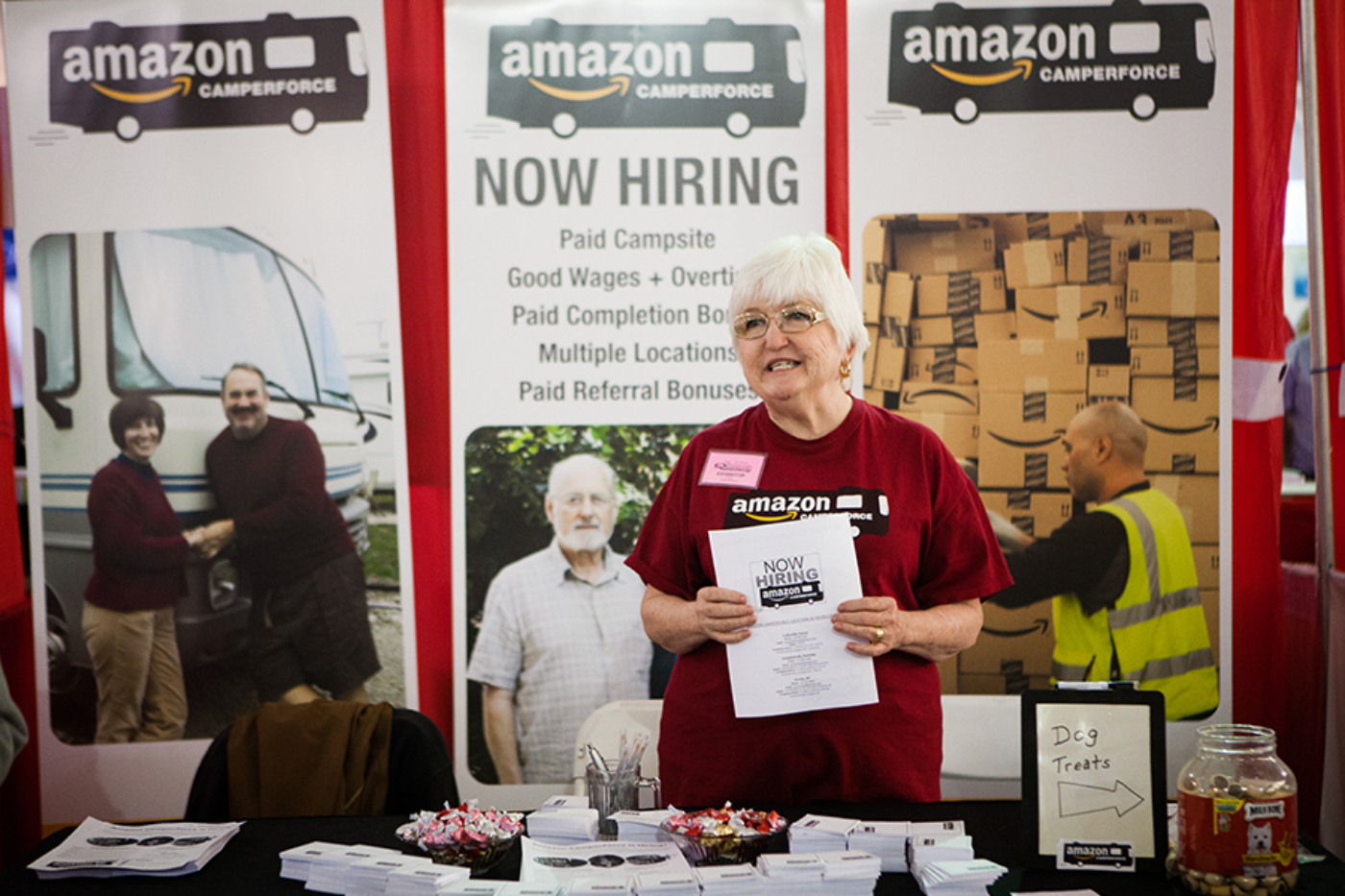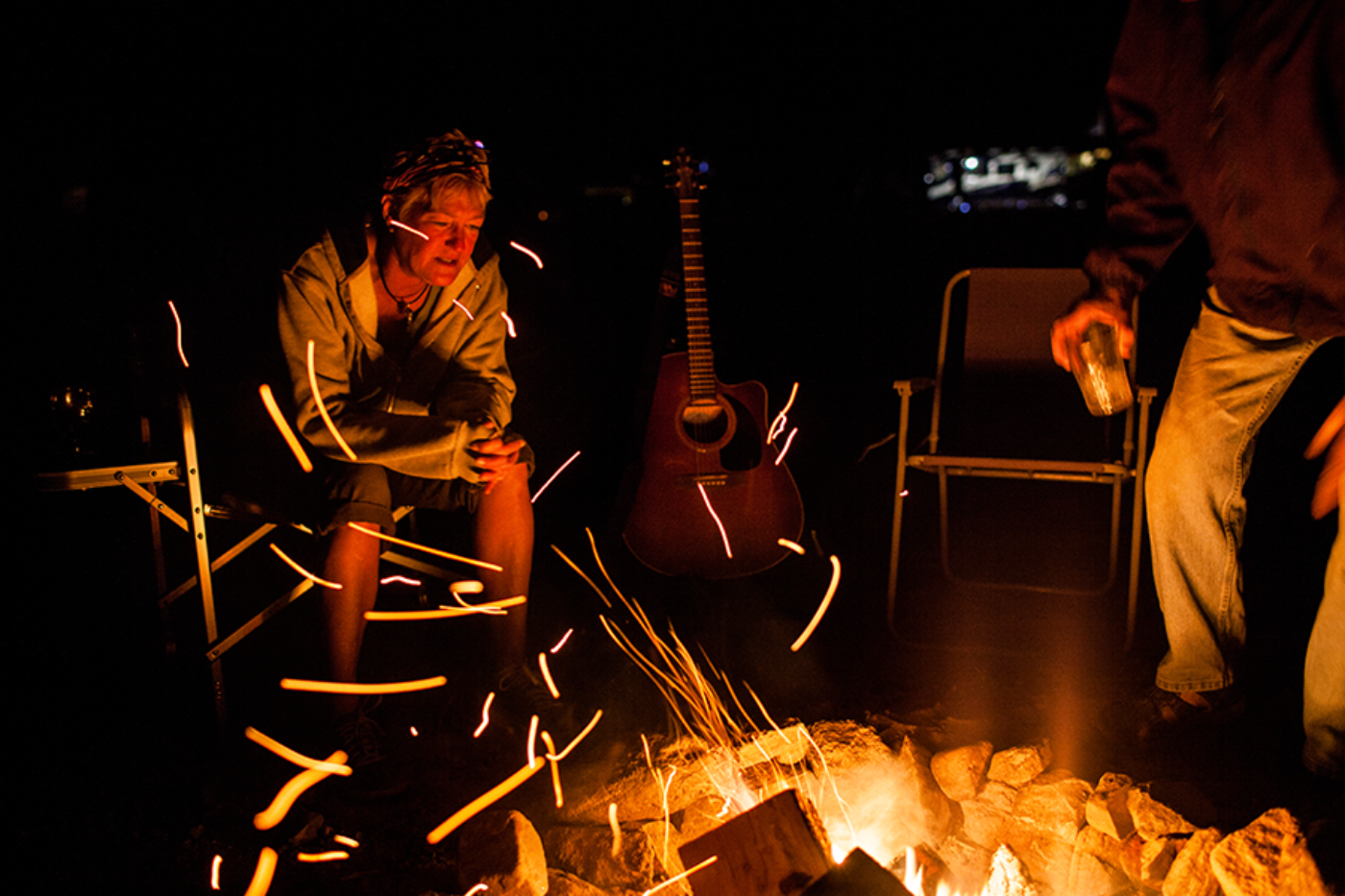
Weeks after leaving her job at Amazon’s warehouse in Fernley, Nevada, migrant worker Linda May still suffers from repetitive strain injuries. All photographs © Max Whittaker
On Thanksgiving Day of 2010, Linda May sat alone in a trailer in New River, Arizona. At sixty, the silver-haired grandmother lacked electricity and running water. She couldn’t find work. Her unemployment benefits had run out, and her daughter’s family, with whom she had lived for many years while holding a series of low-wage jobs, had recently downsized to a smaller apartment. There wasn’t enough room to move back in with them.
“I’m going to drink all the booze. I’m going to turn on the propane. I’m going to pass out and that’ll be it,” she told herself. “And if I wake up, I’m going to light a cigarette and blow us all to hell.”
Her two small dogs were staring at her. May hesitated — could she really envision blowing them up as well? That wasn’t an option. So instead she accepted an invitation to a friend’s house for Thanksgiving dinner.
A couple of years later, May found herself close to the edge again. She was working as a Home Depot cashier for $10.50 an hour, which barely paid for her $600-a-month trailer in Lake Elsinore, California. She wondered, not for the first time, how anybody could afford to grow old. She had held many jobs in her life — building inspector, general contractor, flooring-store owner, insurance executive, cocktail waitress — but none had brought even a modicum of lasting financial security. “Never managed to get myself a pension,” said May, who wears bifocals with rose-colored plastic frames and reveals deep laugh lines when she smiles, which is often. She knew she would soon be eligible for Social Security benefits, but at $499 her monthly checks would not even cover the rent.
Soon after, though, May discovered the philosophy (and the extensive website) of a former Safeway clerk from Alaska named Bob Wells. In 1995, Wells had divorced, gone broke, and moved into a van. As he mastered the transient-survival arts — including “stealth parking” tactics to evade police and tricks for installing solar panels on vehicles — he shared them online. According to Wells, some “vandwellers” subsisted on $500 a month or less, a sum that made immediate sense to May. “If they could do it,” she thought, “I’m sure I could.”
She began to save up for the right vehicle. Then came a windfall: a temporary job at a Veterans Affairs hospital removing signage and repairing walls. The pay was fifty dollars an hour. Within a couple of months, May had accumulated enough cash to buy a 1994 Eldorado motor home with teal and black stripes she’d seen advertised on Craigslist. With only 29,000 miles on its odometer, the twenty-eight-foot RV should have been worth $17,000. But it smelled musty and had a broken generator and a hole in the shower, and a recent collision with a telephone pole had left a football-size crater in the loft above the cab, which had been patched with a smear of caulk that looked like dried toothpaste.
May got the RV for $4,000, then spent another $1,200 to replace the rotted tires. In June, she drove to her first seasonal job, at a campground near Yosemite National Park. For $8.50 an hour plus a place to park the Eldorado, May registered visitors, collected camping fees, and scrubbed toilets.
By late summer, smoke from the Rim wildfire was thickening the air and it was time to move on. May said her goodbyes and drove north. In mid-September, she arrived in Fernley, Nevada, where Amazon runs a warehouse so immense that its workers use the names of neighboring states to navigate its vast interior, calling the western half Nevada and the eastern half Utah. May now joined the company’s CamperForce: a graying labor corps consisting entirely of RV dwellers, many in their sixties or seventies, who work during the peak shopping season that starts in October and ends just before Christmas. She was hired for $12.25 an hour plus overtime to shelve inbound freight. But before her shifts actually began, she went through orientation sessions to acclimate herself to ten-hour workdays spent roaming the concrete-slab floor — a process Amazon refers to as “work hardening.”
“I was in construction and I cocktail-waitressed, which was harder work than construction,” May recalled. “What would I be worried about?”
Click anywhere on a photograph to enlarge
Aging isn’t what it used to be. In an era of disappearing pensions, wage stagnation, and widespread foreclosures, Americans are working longer and leaning more heavily than ever on Social Security, a program designed to supplement (rather than fully fund) retirement. For many, surviving the golden years now requires creative lifestyle adjustments. And for those riding the economy’s outermost edge, adaptation may now mean giving up what full-time RV dwellers call “stick houses” to hit the road and seek work.
May is a member of that tribe. Many of her peers describe themselves as retired, even if they are obliged to keep working well into their seventies or eighties. They call themselves workampers, travelers, nomads, and gypsies, while history-minded commentators have labeled them the Okies of the Great Recession. More bluntly, they are geriatric migrant labor, meeting demands for seasonal work in an increasingly fragmented, temp-driven marketplace. And whatever you call them, they’re part of a demographic that in the past several years has grown with alarming speed: downwardly mobile older Americans.
“We’re facing the first-ever reversal in retirement security in modern U.S. history,” Monique Morrissey of the Economic Policy Institute in Washington, D.C., told me. “Starting with the younger baby boomers, each successive generation is now doing worse than previous generations in terms of their ability to retire without seeing a drop in living standards.”
That means no rest for the aging. Nearly 7.7 million Americans sixty-five and older were still employed last year, up 60 percent from a decade earlier. And while 71 percent of Americans aged fifty to sixty-five envision retirement as “a time of leisure,” according to a recent AARP survey, only 17 percent anticipate that they won’t work at all in their later years.
Of course, some older laborers remain in the workforce to stay busy and socially engaged. But most lack the luxury of choice — and since many of the regular jobs eliminated since 2008 will never come back, the seasonal work available to RV dwellers becomes even more tempting. There’s a national circuit extending from coast to coast and up into Canada, a labor market whose hundreds of employers post classified ads on websites with names like Workers on Wheels and Workamper News. As compensation, some offer only a version of bed and board — a place to park, with hookups for water, electricity, and sewage — while others pay an hourly wage.
Depending on the time of year, these geriatric migrants may be summoned to roadside stalls selling Christmas trees, Halloween pumpkins, or Fourth of July fireworks. They’re sought to pick raspberries in Vermont, apples in Washington, and blueberries in Kentucky. They give tours at fish hatcheries, take tickets at NASCAR races, and guard gates at Texas oil fields.1 They maintain hundreds of campgrounds and trailer parks from the Grand Canyon to Niagara Falls, recruited by private concessionaires along with the U.S. Forest Service and the Army Corps of Engineers. They staff many of the nation’s prime tourist traps, from Dolly Parton’s Dollywood theme park in Tennessee to Wall Drug, the kitschy roadside mall in South Dakota with its eighty-foot-long concrete brontosaurus and animatronic singing cowboys.
And then there is the annual sugar-beet harvest. The last week of September, the American Crystal Sugar Company musters hundreds of RV dwellers to Montana, North Dakota, and Minnesota. Weather permitting, they work day and night in twelve-hour shifts. What they get in return is a starting wage of twelve dollars an hour plus overtime, along with the standard parking space. American Crystal, which has been losing seasonal laborers to the booming oil fields of the Bakken formation, hopes to import 600 workampers this fall, and a recent recruitment flyer invites them to “Be Part of an ‘Unbeetable’ Experience!”
“It was cold. It was snowy. It was wet,” recalled Gretchen Erb, a sixty-nine-year-old widow who lives full-time in a 1999 Fleetwood Bounder RV. Assigned the overnight shift in Minnesota two years ago, she stood outdoors in subfreezing temperatures to collect paperwork from truck drivers and “take samples” — i.e., to fill and lift thirty-pound sacks of produce. Another worker, sixty-two-year-old Brian Gore, described driving a Bobcat loader with a broken-off door during the 2013 harvest and getting pelted with sugar beets — including one the size of a grapefruit — that flew off a malfunctioning conveyor belt. He compared the experience to being strafed by “an automatic potato gun.”
Of all the programs seeking workampers, the largest and most rapidly expanding is Amazon’s CamperForce. It began as an experiment in 2008, when a handful of RV dwellers were hired for the pre-Christmas rush at the company’s warehouse in Coffeyville, Kansas. Pleased with the results, executives branded the program, gave it a logo — the black silhouette of an RV in motion, bearing the company’s smile insignia — and expanded it to warehouses in Campbellsville, Kentucky, and Fernley, Nevada. Over the past two years, Amazon has also begun hiring veteran CamperForce members to train workers at new distribution centers in Tracy, California; Murfreesboro, Tennessee; and Robbinsville, New Jersey. The company doesn’t publicly disclose the program’s size, but in January, when I asked a manager in an Amazon recruiting booth in Arizona, she estimated the number at 2,000 workers.
Workampers are plug-and-play labor, the epitome of convenience for employers in search of seasonal staffing. They appear where and when they are needed. They bring their own homes, transforming trailer parks into ephemeral company towns that empty out once the jobs are gone. They aren’t around long enough to unionize. On jobs that are physically difficult, many are too tired even to socialize after their shifts.
They also demand little in the way of benefits or protections. On the contrary, among the more than fifty such laborers I interviewed, most expressed appreciation for whatever semblance of stability their short-term jobs offered. Take fifty-seven-year-old Joanne Johnson, who was dashing upstairs last October at Amazon’s Campbellsville facility when she tripped and fell, striking her head on a conveyor-belt support bar. She was bandaged up at AmCare — an in-house medical station — and then rushed to an emergency room. The episode left her with two black eyes and nine stitches along her hairline. “They let me continue working. They didn’t fire me,” Johnson recalled warmly. And the day after she was injured, a human-resources representative visited the RV she shared with her sixty-seven-year-old husband, a former workamper. Johnson, who had promised her employers that she would never run up the stairs again, was thunderstruck: “We thought that was one of the most amazing things in the world, that he literally took time away to come to our door to see how we were doing.”
Why would a company like Amazon welcome older candidates for jobs that seem better suited to younger bodies? “It’s because we’re so dependable,” suggested Johnson. “We know that if you commit to something, you do your best to get that job done. We don’t take days off unless we have to.” (While recuperating from her head wound, Johnson missed only one scheduled workday. It was unpaid.)
Paul Sturm, a former CamperForce recruiter, agreed, testifying to the industriousness of “senior folks.” On the occasions when they seemed to be moving slowly, he recalled, it was only “because they were stopping to pick up trash on their way back to boxing up packages, which they did with a smile, for however many hours a day.” And what of the physical rigors of the job? Elderly temps often told Sturm that working for CamperForce was like having a “free fitness program.” One warehouse regular actually blogged about her “cat-food weightlifting” regimen. “Made me feel like crap,” confessed Sturm, who is thirty-five. He laughed and added: “Here I am in HR, and I don’t know if I could do this or not.” (When I first told him of my plan to visit CamperForce’s RV parks, Sturm said the best time would be late October, because “folks wouldn’t be quite so exhausted yet.”)
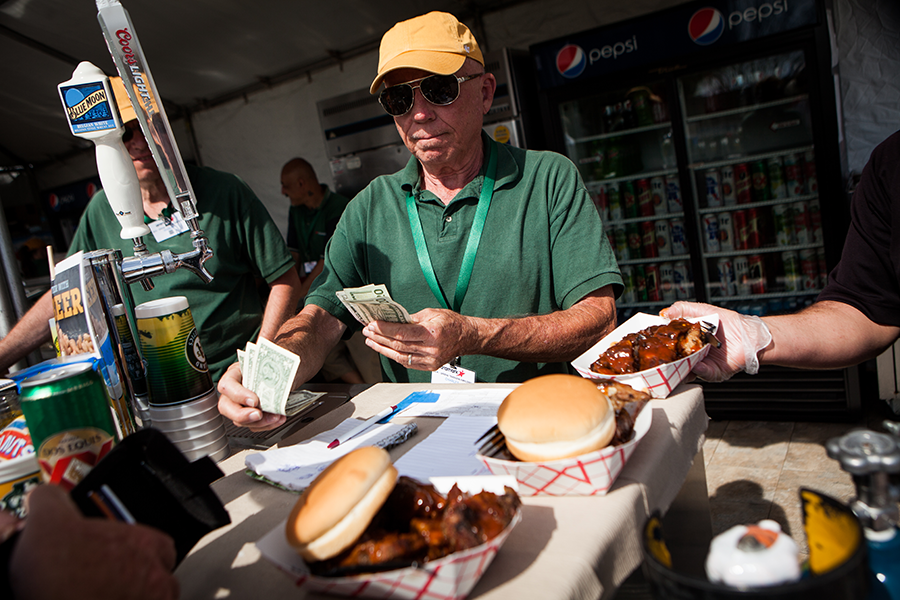
Workamper, blogger, author, and former cowboy Brian Gore in his RV in the desert outside Quartzsite
After two five-hour days of work hardening and training in both safety and job skills, May began settling into her new routine at the Fernley warehouse. She had requested the overnight shift, since the hourly wage was seventy-five cents higher: she worked from six p.m. until four-thirty a.m., with two fifteen-minute breaks and thirty minutes for a quick meal. “I was sleeping all day,” May said. “That kind of changes your life.” After rising in the early afternoon, she typically had a two-hour window to do chores, prepare a bag lunch, and walk her dogs around Sage Valley RV Park, a fenced-off gravel patch dotted with cottonwoods off Highway 50 in Fallon, Nevada. Then she would make the twenty-three-mile commute back to the warehouse.
Early on, the biggest challenge was tedium. When each shift began, May donned an orange reflective vest and a lanyard with her security badge, grabbed a freshly charged battery for her handheld scanner, and went to “stand-up” — a gathering where workers do stretches as supervisors rattle off productivity goals. Next she hit the floor, scanning UPC bar codes while shelving thousands of products that arrived in tote bags and on dollies. “You have a cart with fourteen tubs of Chinese junk,” May told me. “One of the depressing parts was I knew all this stuff was going to end up in a landfill.”
She played mind games to carve up the hours. “I’m only staying here five more minutes, then I’m leaving. I’m quitting. This is it!” she told herself over and over. Then, a couple of hours before sunrise, she and her fellow workers would clock out and queue up to pass through a bank of metal detectors installed as part of the company’s antitheft strategy.2
Despite the boredom, May was grateful for one part of her job. “The best thing was the camaraderie,” she said. “I made friends there.” When she first reached the area around Fernley, hundreds of workampers were arriving on the same migratory wave and settling in as far as thirty-five miles from the Amazon warehouse. (Site reservations had been made months in advance; many parks, particularly those closest to the facility, now had wait lists.) Once the newcomers connected their electric, water, and sewer hookups, they set out doormats and patio furniture and hung wind chimes and bird feeders from the cottonwoods. They raised flags emblazoned with america the beautiful and it’s 5 o’clock somewhere. They displayed homemade yard art, including a cantaloupe-size flying eyeball mounted on an inverted steering column, with several forks welded to each side for wings. They put up Halloween decorations: hay bales, dried cornstalks, a pumpkin covered in pink glitter. They formed car pools to save gas money and swapped advice on inexpensive restaurants for a day-off treat. (Their favorite? The Gold Pan Special at the Pioneer Crossing Casino in Fernley: two eggs and two buttermilk pancakes with bacon, sausage, or ham, plus a side of hash browns or home fries, all for only $2.70 once you factored in the 10 percent senior discount.)
The camps soon developed small-scale economies, run by the stay-at-home partners of warehouse workers. They hawked their services — dog walking, cooking, sewing, upholstery repair, painting lessons for beginners — on bulletin boards in the communal laundry rooms. And the more stories you heard from the campers, the more you realized that the camps were themselves microcosms of the national economic catastrophe. They were jammed with aging Americans who had fallen a long, long way from the middle-class comforts they had always taken for granted.
Chuck Stout, a seventy-year-old warehouse picker, spent forty-five years with the McDonald’s Corporation, where he was a white-collar employee and served as director of product development in the late 1970s. But he and his wife, Barbara, saw his nest egg — $210,000 in investments — vaporize in the stock market. He declared bankruptcy in 2011, and the couple lost their house in a gated community in Myrtle Beach, South Carolina, eventually moving into a 1996 National Sea Breeze RV. Stout estimated that he walked about thirteen miles a day for his Amazon gig. (Their next job, I later learned, was selling beer and burgers at spring-training games for the Oakland A’s.)
“The first time you sleep in your car downtown, you feel like a horrible failure or a homeless person,” said Silvianne Delmars, who worked stowing merchandise at the Fernley warehouse. “But that’s the great thing about people: we make everything habit.” Delmars was a tarot reader who had suffered a run of bad luck: a stolen car, a broken wrist (no insurance), a house in New Mexico that she couldn’t sell. Now she was living in a Ford E350 Super Club Wagon, which had been a transit van for senior citizens and convict labor crews before she named it the Queen María Esmeralda and transformed the interior with jewel-tone scarves, embroidered pillows, Christmas lights, candles, potted basil, and a statuette of Sekhmet, the lion-headed Egyptian goddess.
By late October, evening temperatures in Fernley had dipped below freezing. Snow dusted the trailer parks before Halloween. December brought subzero nights. Veteran campers knew a few tricks, such as wrapping water hoses in heat tape and insulating windows with bubble wrap, but there were limits. One of May’s heroes — Jim Melvin, whose Jimbo’s Journeys blog had first alerted her to Amazon’s seasonal jobs — rushed into town to buy an electric pet-bed warmer and a space heater for his two-pound chihuahua.
May disconnected her water lines. When she tried to decouple her sewage hose, she found that the waste inside had already frozen. It was, she recalled, “nasty.”
In addition to rough weather, hard work wore on the campers. Karren Chamberlen, a sixty-eight-year-old former bus driver with two hip replacements, told me she’d quit CamperForce after five weeks because her knees couldn’t handle the long hours walking on concrete. During a visit to another Amazon encampment — Big Chief RV Park in Coffeyville — I met Kenny Harper, who left soon after. Later, in an email, he explained that “my left rotator won’t take the job.” Other workers talked about “trigger finger,” a tendon condition that can be brought on by repetitive tasks such as UPC-scanner use. And many of the RVs I entered were stocked like mobile apothecaries, with Icy Hot Pain Relieving Gel, tubs for soaking tired feet, Epsom salts, and bottles of Aleve and Advil. (I was told that Amazon distributed free over-the-counter pain relievers at the warehouse.)
“This is the first time I’ve ever done factory work. I’ve got a whole new respect for it,” Linda Chesser, a former Washington State University academic adviser, told me while hanging shirts in the laundry room of the Desert Rose, another Fernley RV park. The sixty-eight-year-old added that she was thankful for ibuprofen. “I take four when I leave for work in the morning and four when I get back at night.”
May began fantasizing about her next destination, which would be warmer and less exhausting. Like many of her neighbors, she planned a pilgrimage to Quartzsite, Arizona, a migrants’ Shangri-la in the Sonoran Desert. The full-time residents of the town number only about 3,400. But every year, several hundred thousand RV dwellers gather there to spend the winter parked amid towering saguaro cacti. Many take advantage of the federal public land, where they’re allowed to “boondock” without the usual utility hookups for free, powering their rigs with solar panels or gas generators. They go financially dormant, spending almost no money. One workamper described Quartzsite as “Burning Man for geezers.” And not surprisingly, corporate recruiters follow the migration there.
Meanwhile, the winter didn’t let go so easily. There were mandatory fifty-hour overtime weeks. And May had a health scare. She had been holding up well, despite straining her wrist with the UPC scanner. (More than a month after the Amazon job ended, she would still sometimes wear a brace to alleviate the swelling.) But on December 15, two weeks before her last day at the warehouse in Fernley, she began having dizzy spells. An hour later, her attempts at deep breathing weren’t helping, so a co-worker escorted her to AmCare, where the medical staff took her blood pressure: sixty over forty-eight. Low enough to call an ambulance.
At the hospital in Reno, half an hour’s drive west, May underwent a CAT scan and an X-ray but received no conclusive diagnosis. “The nurse at the hospital said I could have compressed something on the vagus nerve,” May recalled. “That’ll make you pass out. You can get it from straining.” She sounded skeptical, since she didn’t think she had been pushing herself that hard. In any case, she was instructed to follow up with her primary-care physician. (“Yeah, I’d do that if I had one,” she said, laughing. Like most workampers I met, May was uninsured.)
She paid $172 for a cab back to Sage Valley RV Park. For the next few days, she felt weak, took time off. Later, in Quartzsite, I asked May how she’d felt finishing work on December 30. She didn’t hesitate. “Let me get the hell out of here!” she remembered thinking. “Put the pedal to the metal. Let’s go!”
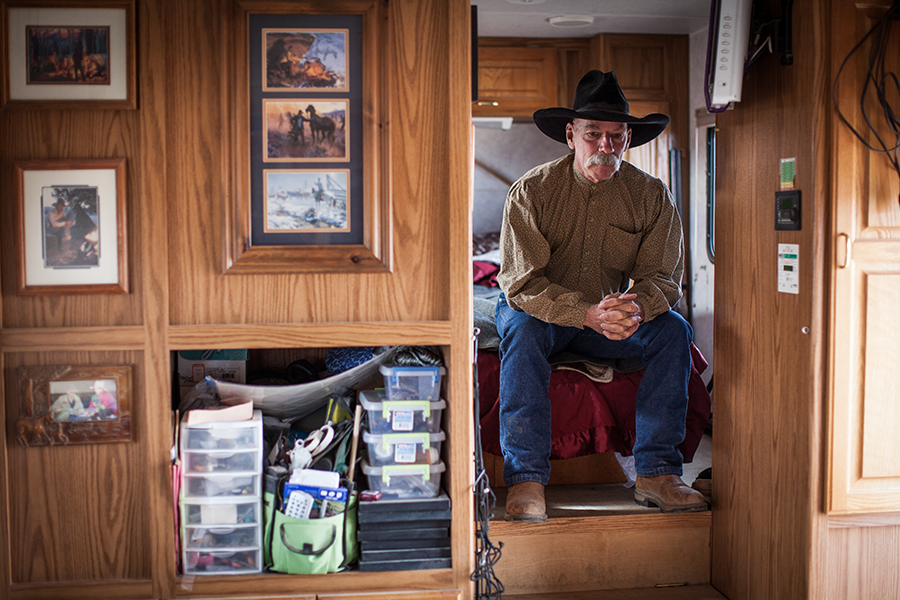
Workamper, blogger, author, and former cowboy Brian Gore in his RV in the desert outside Quartzsite
The very idea of retirement is a relatively new invention. For most of human history, people worked until they died or were too infirm to lift a finger (at which point they died pretty fast anyway). It was the German statesman Otto von Bismarck who first floated the concept, in 1883, when he proposed that his unemployed countrymen over the age of sixty-five be given a pension. This move was designed to fend off Marxist agitation — and to do so on the cheap, since few Germans survived to that ripe old age.
William Osler, a celebrated physician who helped to found the Johns Hopkins School of Medicine, was instrumental in bringing the idea to the English-speaking world. His rationale was physiological and, to a certain extent, economic. Workers peaked at forty, he argued, then went downhill until they hit their sixties — at which point, Osler prankishly suggested, they might as well be chloroformed (an idea Osler borrowed from Anthony Trollope’s The Fixed Period). The pension advocate Lee Welling Squier expressed a similar idea in 1912, in considerably less comic terms:
After the age of sixty has been reached, the transition from non-dependence to dependence is an easy stage — property gone, friends passed away or removed, relatives become few, ambition collapsed, only a few short years left to live, with death a final and welcome end to it all — such conclusions inevitably sweep the wage-earner from hopeful independent citizen into that of the helpless poor.
In this country, it was the Great Depression that made retirement into a reality. There were too many workers, too few jobs, and a consequent sense that the elderly needed to be nudged out of the labor pool. Francis Townsend, a California physician who had also farmed hay and managed a failing dry-ice factory, began lobbying for what came to be known as the Townsend Plan: if a worker retired at sixty, the federal government would reward him with a monthly pension of up to $200. It was partly in response to this populist initiative that FDR and a Democratic Congress passed the Social Security Act of 1935 — which, unlike the Townsend Plan, required future retirees to chip in to a common fund throughout their working lives.
After the New Deal, economists began referring to America’s retirement-finance model as a “three-legged stool.” This sturdy tripod was composed of Social Security, private pensions, and combined investments and savings. In recent years, of course, two of these legs have been kicked out. Many Americans saw their assets destroyed by the Great Recession; even before the economic collapse, many had been saving less and less. And since the 1980s, employers have been replacing defined-benefit pensions with 401(k) plans, which were originally marketed as instruments of financial liberation that would allow workers to make their own investment choices. (The upshot: Employers saved money. Workers got shafted.)
All of which is to say that Social Security is now the largest single source of income for most Americans sixty-five or older. But economists agree that it’s woefully inadequate. Nearly half of middle-class workers may be forced to live on a food budget of as little as five dollars a day when they retire, according to Teresa Ghilarducci, an economist and professor at the New School in New York City. “I call it the end of retirement,” she told me. Many retirees simply can’t survive without some sort of paycheck. Meanwhile, Ghilarducci noted, jobs for older Americans are paying less and becoming ever more physically taxing. She worries we’re returning to the world that Lee Welling Squier described more than a century ago. And any serious discussion of the problem, she added, is complicated by a cultural stigma.
“I never talk about this issue in terms of ‘retirement,’ ” Ghilarducci said. Americans traditionally abhor the idea “that you are mooching or you’re not productive.”
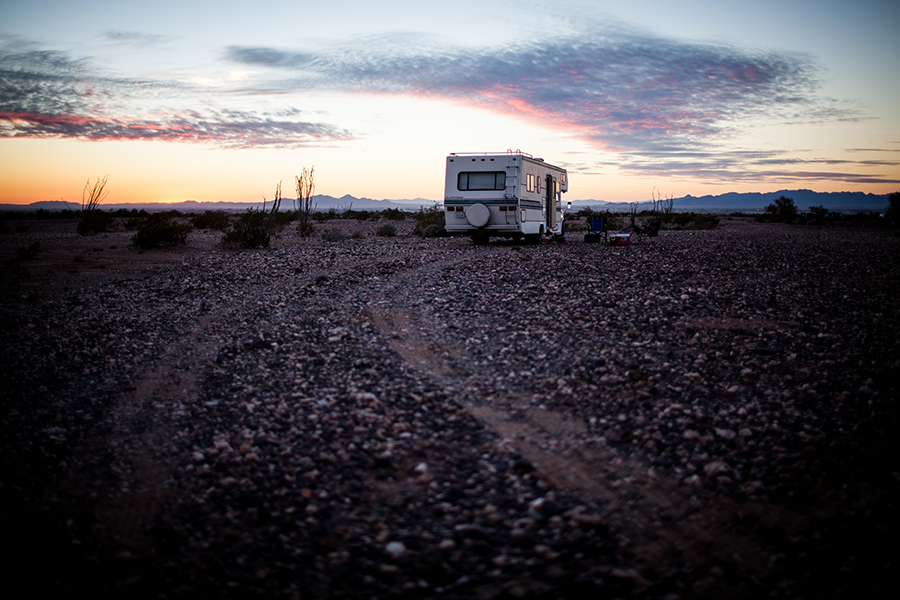
Linda May’s mobile home in the desert outside Ehrenberg
As you drive west on Interstate 10 into a January sunset, a strange vision appears not far from Quartzsite. Thousands of gold specks glitter at the base of the Dome Rock Mountains, as if the peaks were surrounded by a vast reflecting pool. Up close, the sparkling dots break apart into a sprawl of RVs, their windshields catching the last rays of daylight.
In addition to three small motels, Quartzsite has about seventy RV parks, most reserved for guests fifty-five or older. There’s the Cactus Patch, the Desert Oasis, La-Z-Daze, Winter Haven, Coyote Pass, Happy J’s. On Main Street, the entrances to these parks alternate with flea markets and RV dealerships, which were attracting scant foot traffic when I visited last winter.
At the Church of the Isaiah 58 Project on South Moon Mountain Avenue, a biker-turned-pastor named Mike Hobby was running his seasonal soup kitchen, which serves thousands of elderly and homeless people from November through March. He told me that transient old folks flock to Quartzsite because it’s “a cheap place to hide.” During a pasta supper at the church, I met Leonard Scott, a former gas-station owner with a gray ponytail under a jesus is lord trucker hat. The sixty-three-year-old was living in a 1995 Winnebago: “I lost my empire” — two homes and a duplex he had bought as investment properties — “when the economy collapsed.” He had worked at a hot spring in Tonopah, Arizona, to supplement his monthly $590 Social Security check, and was planning to join friends in the Pacific Northwest picking morel mushrooms, which he heard fetched ten dollars an ounce. Eventually, Scott said, he hoped to move to a beach in Kauai and live off fruit from the trees.
When May arrived in Quartzsite, she joined the Rubber Tramp Rendezvous: five dozen RVs parked at Scaddan Wash, a desert area east of the town with free camping. Bob Wells, the van-dwelling guru, had organized the gathering. Most attendees had learned about the Rubber Tramp Rendezvous through his website, where traffic, he said, first exploded in 2008. There were people, Wells told me, who simply couldn’t survive in this economy “if they don’t move into a van and live on public land.”
They shared nightly bonfires, chili dinners, and storage tips. During an “open house” session, they toured one another’s rigs. They debated the best state for establishing residency: South Dakota and Texas were popular because they lack an income tax and have low rates for vehicle insurance and registration. There were seminars on boondocking, cooking with fire, tire repair, budgeting, solar power, and how to find cut-rate dentistry in Los Algodones, Mexico. (Almost everyone I met had taken a trip to “tooth town.”) And there was a pervasive feeling of pride. Most shared the attitude of Al Christensen, a sixty-two-year-old former advertising art director who viewed his Chevy van as a “rolling steel tent.” He preferred to call himself “houseless,” he told me, rather than “homeless.”
Since this was May’s first visit to Quartzsite and the rendezvous alike, I asked how she was finding it. “Oh my God,” she said, explaining that it was a relief to be around people who she felt understood her. “The other day, for the first time in years and years, I felt joy. Joy! That’s better than being happy.” Before long, May was helping two of her neighbors — a former radio journalist named LaVonne Ellis in a maroon GMC Safari and Trish Hay, a fifty-nine-year-old in a Nissan Sentra — apply for campground-maintenance jobs with her previous employer near Yosemite.
Elsewhere at Scaddan Wash, an impromptu CamperForce reunion drew nine former Amazonians and a retired police officer. They sang parts of “The Twelve Days of Amazon” — a proletarian parody including the lyric “ten sore muscles” — and drew names from a hat for Amazon-branded swag such as key chains, bottle openers, lanyards, and flash drives.
In late January came the unofficial culmination of the migrants’ sojourn: the 31st Annual Quartzsite Sports, Vacation & RV Show, known locally as the Big Tent. With more than 200 exhibitors, it felt like a giant infomercial. Many booths peddled pain cures. Others promised relief from an alphabet of ills, from anxiety and arthritis to backache and bunions, gout and heel spurs to sore muscles and sciatica.
There were recruitment tables, too. Amazon’s CamperForce, a theme park called Adventureland, and several firms managing national parks sent representatives, all urging passersby to take applications. One had even brought uniforms to give new employees. Express Employment Professionals were seeking workers for the beet harvest. “If you’re willing to fill out an application, then you’re hired for the coming season,” the recruiter told me. “We would hire you today.”
During my stops in Nevada and Kansas, along with three weeks tenting on federal land south of Quartzsite, a pattern emerged. Unprompted, many workampers told me how happy they were. How free. What an adventure it was. That everything had happened for a reason.
I nodded along. I liked these people, so I wanted to believe. Still, I grew increasingly worried about them: under the carefree veneer, it was hard not to read something darker. I began wondering: What happens to all these people when they’re too old to scrub campsite toilets or walk ten hours a day in an Amazon warehouse or lift thirty-pound sacks of sugar beets in the cold? When they can’t see well enough to drive cumbersome rigs on the highway? Some geriatric migrants I met already seemed one injury or broken axle away from true homelessness. Vans and trailers don’t last forever. Neither do bodies.
I heard about Rainbow’s End, a trailer park in Livingston, Texas, with medical care in an adjacent facility for RV dwellers who were too old to drive. But I also heard much bleaker stories. Iris Goldenberg, a former wound-care technician in a Colorado hospital, recounted how an acquaintance named Ron drank himself to death while boondocking in a Walmart parking lot thirty-six miles from Quartzsite. No one found his body for a month, she said. An Isaiah 58 Project volunteer, Becky Hill, told me that an eighty-year-old who had taken shelter at their church for three months later turned up dead in his RV in the desert near Ehrenberg, Arizona.
What would be the endgame for this new generation of aging migrants? “In my mind, I’m going to be doing this forever,” said Delmars, the tarot reader. “I don’t care if it comes to the Thelma & Louise thing and all I can do is drive over a cliff.” Bob Wells had a more practical plan for his declining years: “I’m going to dig a big, long trench and buy a cheap school bus and backfill completely over one side and over the roof, with windows on the south side. You can buy a crap school bus that’s not running for five hundred dollars. It’s tough as nails and will last forever.” And Goldenberg? “Just find me dead in the desert. Put rocks over me and let me go.”
Finally, I asked May what she planned to do. “I’ll show you,” she said, gently setting a three-ring binder on the table of her kitchenette. Inside were pictures of an Earthship — a passive-solar house made of recycled materials such as cans and bottles, with dirt-filled tires for its load-bearing walls. May wanted to build one. She had seen four-acre parcels offered for less than $5,000 in Cochise County, Arizona, and planned to make a scouting trip there before starting her next job, hosting campsites in Mammoth Lakes, California. “This is the garden where you grow food,” she said, pointing to another photograph.
After I left Quartzsite, May updated me with text messages as she hunted for land, liquidated the contents of her rented storage unit in Goodyear, Arizona (“I’d just like to throw a match in there, I think,” she had joked earlier), and reunited with Rubber Tramp Rendezvous friends for a pizza party. She sent me a favorite quote she’d found online, praising those who “cut every tether holding you from freedom.”
In early spring, May posted on Facebook a picture of her refrigerator, which was empty apart from a few condiments plus four eggs and half a gallon of milk. She wrote that earlier in the month, when things had gotten tighter, she had made old tortillas into chilaquiles and stale bread into a French-toast casserole. But the photo of her fridge, she explained, was already outdated. “I made it to payday,” May wrote. “So I went grocery shopping and filled it up.”
I last reached May by phone as she worked at Mammoth Lakes. “It’s a lovely day! My campground is full,” she told me. I asked whether she had found a parcel of land yet. She said the acreage in Arizona had proved too remote. “I thought: Nobody’s going to come here. I’d better find land where family can come,” she explained, adding that she had shifted her focus to Julian, California, in the Mojave Desert, west of the Salton Sea. There was a new plan, too. Her daughter would pay for the land and May would build the Earthship. It would be their shared legacy, put into a trust for May’s grandchildren.
May told me she was doing fabulously. “My whole life has been ups and downs,” she said. “The happiest I’ve been is when I have very little.” We talked about her dogs, about how she hoped to refurbish her RV. Before long, though, she had to excuse herself (“Looks like I’ve got a camper coming to my door!”) and get back to work.


